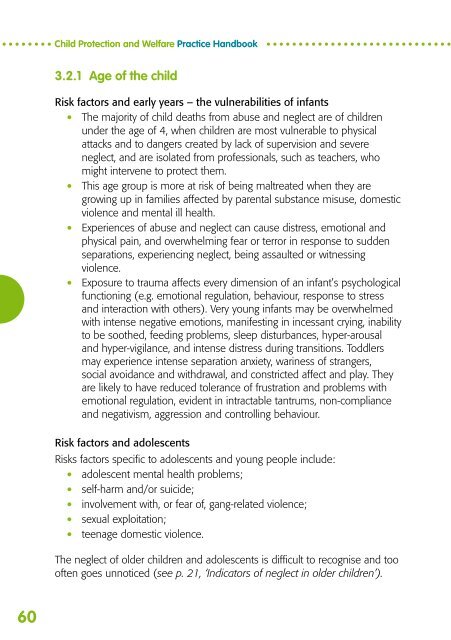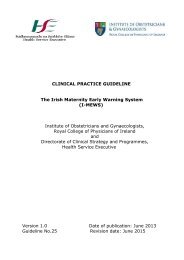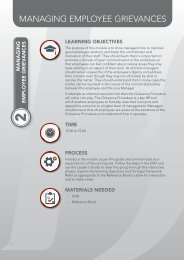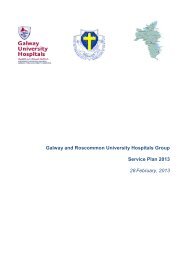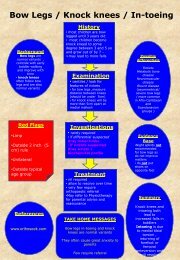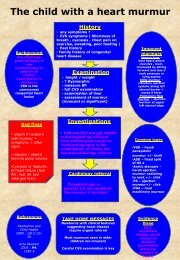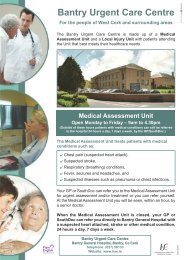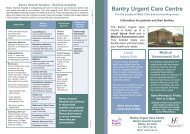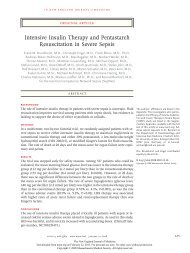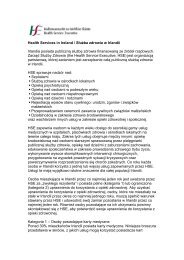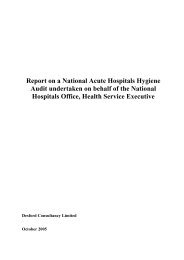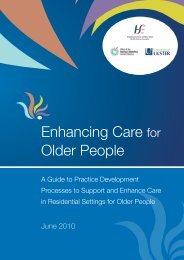Child Protection and Welfare Practice Handbook - Health Service ...
Child Protection and Welfare Practice Handbook - Health Service ...
Child Protection and Welfare Practice Handbook - Health Service ...
You also want an ePaper? Increase the reach of your titles
YUMPU automatically turns print PDFs into web optimized ePapers that Google loves.
60<br />
<strong>Child</strong> <strong>Protection</strong> <strong>and</strong> <strong>Welfare</strong> <strong>Practice</strong> H<strong>and</strong>book<br />
3.2.1 Age of the child<br />
Risk factors <strong>and</strong> early years – the vulnerabilities of infants<br />
• The majority of child deaths from abuse <strong>and</strong> neglect are of children<br />
under the age of 4, when children are most vulnerable to physical<br />
attacks <strong>and</strong> to dangers created by lack of supervision <strong>and</strong> severe<br />
neglect, <strong>and</strong> are isolated from professionals, such as teachers, who<br />
might intervene to protect them.<br />
• This age group is more at risk of being maltreated when they are<br />
growing up in families affected by parental substance misuse, domestic<br />
violence <strong>and</strong> mental ill health.<br />
• Experiences of abuse <strong>and</strong> neglect can cause distress, emotional <strong>and</strong><br />
physical pain, <strong>and</strong> overwhelming fear or terror in response to sudden<br />
separations, experiencing neglect, being assaulted or witnessing<br />
violence.<br />
• Exposure to trauma affects every dimension of an infant’s psychological<br />
functioning (e.g. emotional regulation, behaviour, response to stress<br />
<strong>and</strong> interaction with others). Very young infants may be overwhelmed<br />
with intense negative emotions, manifesting in incessant crying, inability<br />
to be soothed, feeding problems, sleep disturbances, hyper-arousal<br />
<strong>and</strong> hyper-vigilance, <strong>and</strong> intense distress during transitions. Toddlers<br />
may experience intense separation anxiety, wariness of strangers,<br />
social avoidance <strong>and</strong> withdrawal, <strong>and</strong> constricted affect <strong>and</strong> play. They<br />
are likely to have reduced tolerance of frustration <strong>and</strong> problems with<br />
emotional regulation, evident in intractable tantrums, non-compliance<br />
<strong>and</strong> negativism, aggression <strong>and</strong> controlling behaviour.<br />
Risk factors <strong>and</strong> adolescents<br />
Risks factors specific to adolescents <strong>and</strong> young people include:<br />
adolescent mental health problems;<br />
• self-harm <strong>and</strong>/or suicide;<br />
• involvement with, or fear of, gang-related violence;<br />
• sexual exploitation;<br />
• teenage domestic violence.<br />
•<br />
The neglect of older children <strong>and</strong> adolescents is difficult to recognise <strong>and</strong> too<br />
often goes unnoticed (see p. 21, ‘Indicators of neglect in older children’).


